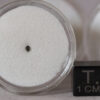Description
On offer: a fragment of this rare meteorite fall.
Dimensions: ~1 x 1 mm
What you get: a randomly selected fragment, a plastic box, a label and signed Certificate of Authenticity.
Type: CI1 chondrite
Country: France, Tarn-et-Garonne
Date of fall: May 14, 1864
Total mass: 14 kg
May 14, 1864, at 8pm, a meteor goes through the french sky. It is observed in the Eure department, in Bordeaux or even in Agen. It flies over the city of Montauban before exploding violently at 10 kilometers between Nohic and Monbéqui, from a west-northwest – east-southeast axis. Numerous fragments are recovered. The Orgueil meteorite is one of the first carbonaceous chondrite ever found and its scientific interest is considerable. Shortly after its discovery, a controversy arose as some scientists believed to have detected traces of extraterrestrial fossil life in it. This was obviously a hoax.
In 2006, M. Gounelle, P. Spurny and P.A. Bland published a paper in Meteoritics and Planetary Science about the path of the Orgueil meteorite. They found an entry point into the atmosphere at an altitude of 70 km (longitude 0.26° W, latitude 44.29° N) and an explosion point at an altitude of 19 km (longitude 1.34°E, latitude 43.89°N) after a 150 km course in the sky. The calculation of the orbit indicated that the Orgueil meteorite is from a cometary origin !
Finally, in 2011, the analysis of cometary fragments brought back to Earth by the Stardust mission and whose isotopic composition of hydrogen were close to that of Orgueil has confirmed these conclusions.








